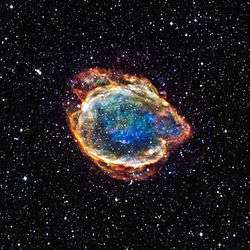Supernova Cosmology Project
The Supernova Cosmology Project is one of two research teams that determined the likelihood of an accelerating universe and therefore a positive cosmological constant, using data from the redshift of Type Ia supernovae.[1] The project is headed by Saul Perlmutter at Lawrence Berkeley National Laboratory, with members from Australia, Chile, France, Portugal, Spain, Sweden, United Kingdom and United States.
This discovery was named "Breakthrough of the Year for 1998" by Science Magazine[2] and, along with the High-z Supernova Search Team, the project team won the 2007 Gruber Prize in Cosmology[3] and the 2015 Breakthrough Prize in Fundamental Physics.[4] In 2011, Perlmutter was awarded the Nobel Prize in Physics for this work, alongside Adam Riess and Brian P. Schmidt from the High-z team.[5]
Project Members
- Saul Perlmutter, Lawrence Berkeley National Laboratory
- Gregory Aldering, Lawrence Berkeley National Laboratory
- Brian J. Boyle, Australia Telescope National Facility
- Patricia G. Castro, Instituto Superior Técnico, Lisbon
- Warrick Couch, Swinburne University of Technology
- Susana Deustua, American Astronomical Society
- Richard Ellis, California Institute of Technology
- Sebastien Fabbro, Instituto Superior Técnico, Lisbon
- Alexei Filippenko, University of California, Berkeley (later a member of the High-z Supernova Search Team)
- Andrew Fruchter, Space Telescope Science Institute
- Gerson Goldhaber, Lawrence Berkeley National Laboratory
- Ariel Goobar, University of Stockholm
- Donald Groom, Lawrence Berkeley National Laboratory
- Isobel Hook, University of Oxford
- Mike Irwin, University of Cambridge
- Alex Kim, Lawrence Berkeley National Laboratory
- Matthew Kim
- Robert Knop, Vanderbilt University
- Julia C. Lee, Harvard University
- Chris Lidman, European Southern Observatory
- Thomas Matheson, NOAO Gemini Science Center
- Richard McMahon, University of Cambridge
- Richard Muller, University of California, Berkeley
- Heidi Newberg, Rensselaer Polytechnic Institute
- Peter Nugent, Lawrence Berkeley National Laboratory
- Nelson Nunes, University of Cambridge
- Reynald Pain, CNRS-IN2P3, Paris
- Nino Panagia, Space Telescope Science Institute
- Carl Pennypacker, University of California, Berkeley
- Robert Quimby, The University of Texas
- Pilar Ruiz-Lapuente, University of Barcelona
- Bradley E. Schaefer, Louisiana State University
- Nicholas Walton, University of Cambridge
References
- ↑ Goldhaber, Gerson (2009). "The Acceleration of the Expansion of the Universe: A Brief Early History of the Supernova Cosmology Project (SCP)". AIP Conference Proceedings. 1166: 53. arXiv:0907.3526
 . Bibcode:2009AIPC.1166...53G. doi:10.1063/1.3232196.
. Bibcode:2009AIPC.1166...53G. doi:10.1063/1.3232196. - ↑ Cosmic Motion Revealed Science 282(5397), 2156-2157
- ↑ Gruber Foundation Prize in Cosmology Press Release
- 1 2 Recipients Of The 2015 Breakthrough Prizes In Fundamental Physics And Life Sciences Announced
- ↑ "Nobel physics prize honours accelerating Universe find". BBC News. 2011-10-04.
- ↑ Gruber Foundation: Saul Perlmutter & the Supernova Cosmology Project

